
Liriodendron tulipifera—known as the tulip tree, American tulip tree, tulipwood, tuliptree, tulip poplar, whitewood, fiddletree, lynn-tree, hickory-poplar, and yellow-poplar—is the North American representative of the two-species genus Liriodendron, and the tallest eastern hardwood. It is native to eastern North America from Southern Ontario and possibly southern Quebec to Illinois eastward to southwestern Massachusetts and Rhode Island, and south to central Florida and Louisiana. It can grow to more than 50 m (160 ft) in virgin cove forests of the Appalachian Mountains, often with no limbs until it reaches 25–30 m (80–100 ft) in height, making it a very valuable timber tree. The tallest individual at the present time (2021) is one called the Fork Ridge Tulip Tree at a secret location in the Great Smoky Mountains of North Carolina. Repeated measurements by laser and tape-drop have shown it to be 191 feet 10 inches (58.47 m) in height. This is the tallest known individual tree in eastern North America.
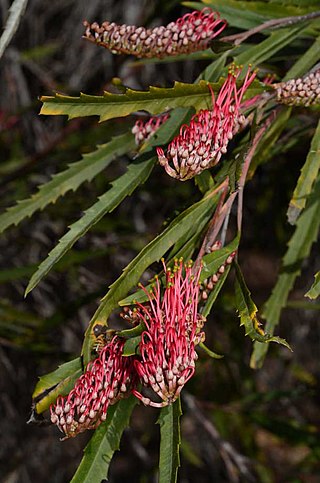
Grevillea longifolia, commonly known as fern-leaf spider flower, is a species of flowering plant in the family Proteaceae and is endemic to the Sydney Basin in New South Wales. It is an erect to spreading shrub with narrowly egg-shaped to almost linear leaves, and toothbrush-like groups of pinkish-fawn flowers with a pink to red style. It is fairly readily grown in gardens.

Tilia americana is a species of tree in the family Malvaceae, native to eastern North America, from southeast Manitoba east to New Brunswick, southwest to northeast Oklahoma, southeast to South Carolina, and west along the Niobrara River to Cherry County, Nebraska. It is the sole representative of its genus in the Western Hemisphere, assuming T. caroliniana is treated as a subspecies or local ecotype of T. americana. Common names include American basswood and American linden.

Cardamine hirsuta, commonly called hairy bittercress, is an annual or biennial species of plant in the family Brassicaceae, and is edible as a salad green. It is common in moist areas around the world.

Pitavia punctata is a species of tree endemic to Chile in the family Rutaceae. It is known by the common names Pitao and Pitran. It grows in native deciduous forests in the Chilean Coast Range of central Chile. It is threatened with habitat loss, and is assessed as Endangered.

Beilschmiedia berteroana is a threatened evergreen tree in the family Lauraceae endemic to Chile at 35 to 37°S.

Kageneckia angustifolia is a species of plant in the family Rosaceae. It is endemic to Chile. It grows from Limari to Talca in the Chilean Coast Range and in the Andes.
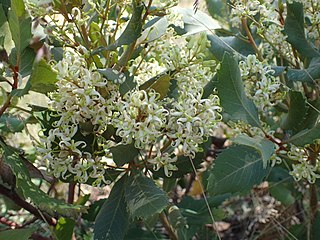
Lomatia fraseri, commonly known as tree lomatia, forest lomatia or silky lomatia is a plant of the family Proteaceae native to eastern Australia. It grows as a shrub or small tree, reaching 8–11 metres (26–36 ft) high, with highly variable leaves. The cream to white inflorescences appear over summer. It is found in rainforest margins, gullies and heathland in mountainous regions of Victoria and New South Wales. It regenerates from fire by regrowing from a lignotuber.

Ipomoea leptophylla, the bush morning glory, bush moonflower or manroot, is a species of flowering plant in the bindweed family, Convolvulaceae.

Caldcluvia is a monotypic genus in the family Cunoniaceae with the only species Caldcluvia paniculata, known as tiaca, an evergreen tree native to Chile. It is found from Ñuble to Aisén. Most species that were previously placed in the genus are now placed in Ackama, Opocunonia and Spiraeopsis.

Lomatia ferruginea, commonly known as fuinque, is a small evergreen tree in the family Proteaceae.

Laureliopsis is a genus of flowering plants with just one species, Laureliopsis philippiana, known as tepa and wawán, endemic to Chile and the narrow neighboring strip of Argentina. In Chile it is found from Maule to Aysén. It grows on humid and deep soils.

Amomyrtus meli, known as meli, is a species of tree in the family Myrtaceae. It is endemic to Chile and grows from Arauco to Chiloe. It grows mostly on moist and shaded sites.

Cinnamomum virens is a rainforest tree growing in the eastern coastal parts of Australia. Common names include red-barked sassafras, black sassafras, camphorwood, scentless cinnamon wood, and native camphor laurel. Its habitat is between the Williams River and the Main Range National Park in Queensland. Growing in rich volcanic soils or on the poorer sedimentary soils, it is often in association with coachwood.
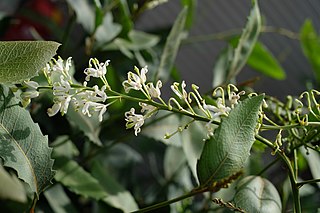
Lomatia ilicifolia, commonly known as holly lomatia or native holly, is a plant in the family Proteaceae and is endemic to south-eastern Australia. It is a stiff, erect shrub with hairy, rust-coloured new growth and which recovers from fire from a lignotuber. It has dull green, leathery, prickly, holly-like leaves and long sprays of cream flowers, usually after fire.

Leichhardtia suaveolens, synonym Marsdenia suaveolens, commonly known as the scented milk vine, is a small vine found in New South Wales, Australia. It is found in a variety of habitats in relatively high rainfall areas, from Bega to Port Macquarie. The original specimen was collected at Sydney on 11 May 1802.

Lomatia myricoides, commonly known as the river lomatia, is a shrub native to New South Wales and Victoria in southeastern Australia.
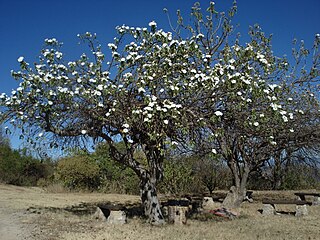
Ipomoea arborescens, the tree morning glory, is a rapidly-growing, semi-succulent flowering tree in the family Convolvulaceae. This tropical plant is mostly found in Mexico, and flowers in late autumn and winter. Its common name in Nahuatl is Cazahuatl or Cazahuate.
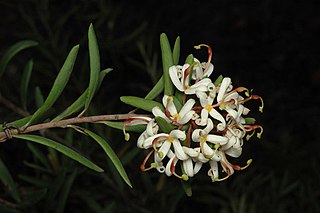
Lomatia polymorpha, commonly known as mountain guitar plant, is a shrub or small tree of the family Proteaceae which is endemic to Tasmania. It is a shrub or small tree with linear leaves, and white, cream-coloured or greenish flowers. It is common throughout its range which is approximately complementary to that of L. tinctoria in Tasmania.

Mairia hirsuta is a tufted perennial, herbaceous plant of up to 40 cm high, that is assigned to the family Asteraceae. Most of its narrow to broad elliptic or inverted egg-shaped leaves are part of the basal rosette, have margin that is rolled under, with rounded or pointy teeth or with some peg-like extensions, lightly woolly on the upper surface and densely woolly on the underside, but always the green remains visible. Flower heads have been found from July to November, mostly after a fire or when the soil has been disturbed. The species can be found in the southern mountains of the Western Cape province of South Africa.




















